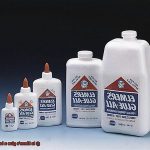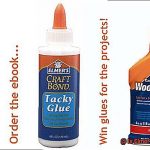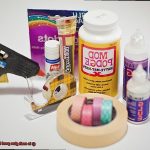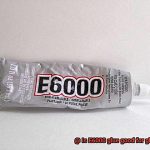Welcome to our blog post where we dive into the age-old debate: is E6000 stronger than super glue?
When it comes to sticking stuff together, finding the right adhesive is a big deal. But fear not, because today we’re gonna break it down for you.
We’ll be exploring the relative strengths of these popular adhesives in all sorts of situations. Glass, metals, plastics, fabrics – you name it, we’ll cover it.
So, let’s get straight to it and find out which adhesive takes the crown.
Overview of E6000 and Super Glue
Contents
- 1 Overview of E6000 and Super Glue
- 2 Strength Comparison Between E6000 and Super Glue
- 3 Advantages of E6000 over Super Glue
- 4 Advantages of Super Glue over E6000
- 5 Effectiveness in Bonding Different Materials
- 6 Application Methods for E6000 and Super Glue
- 7 Drying Times for E6000 and Super Glue
- 8 Factors Affecting the Strength of an Adhesive
- 9 Conclusion
When it comes to gluing things together, two popular options are E6000 and Super Glue. These adhesives are known for their bonding power and versatility, but they have some key differences that make them suitable for different applications.
E6000 is a multi-purpose industrial strength adhesive that is famous for its exceptional bonding power. It can bond materials like metal, wood, glass, ceramics, fabric, leather, and even plastics. E6000 cures to a clear, flexible, and waterproof finish. On the other hand, Super Glue, also known as cyanoacrylate adhesive, is a fast-acting and strong adhesive that bonds quickly to various materials like metal, plastic, rubber, and ceramics. It dries clear and creates a rigid bond.
One of the main differences between E6000 and Super Glue is their working time. E6000 offers a longer working time compared to Super Glue. This means that users have more flexibility in positioning their materials before the adhesive sets. This can be particularly useful when working on complex projects or when precise alignment is required.
In terms of strength, E6000 is generally considered to be stronger than Super Glue. Its industrial strength formula provides a reliable bond that can withstand heavy loads and regular wear and tear. However, the strength of the bond can also depend on factors such as the materials being bonded and the application technique used.
Super Glue, on the other hand, offers an incredibly fast curing time. It forms a bond within seconds of application and reaches its maximum strength within a few minutes. This makes it ideal for quick repairs or situations where immediate bonding is necessary.
Another factor to consider is the odor. E6000 has a distinct odor that some users may find unpleasant. Adequate ventilation is recommended when working with this adhesive.
Both E6000 and Super Glue have their own advantages and are suitable for different applications. If you need a strong and durable bond that can withstand various conditions, E6000 may be the better choice. However, if you need a quick and instant bond for small repairs or non-flexible materials, Super Glue may be more suitable.
Strength Comparison Between E6000 and Super Glue
When it comes to adhesives, there’s more than meets the eye. In one corner, we have E6000, the heavyweight champion of strength and versatility. And in the other corner, we have Super Glue, the lightning-fast sprinter of bonding. So let’s get ready to rumble as we compare and contrast these two adhesive powerhouses.
- E6000 is like the Hulk of adhesives – strong and durable. It can bond a wide range of materials, from metal to fabric. It’s perfect for heavy-duty projects that require a bond that can withstand the test of time. E6000 is also known for its ability to handle tough conditions like temperature changes and moisture without losing its grip. However, this adhesive does take its time to cure, so patience is key.
- On the other hand, Super Glue is like The Flash – quick and efficient. It bonds instantly, making it ideal for those urgent fixes that can’t wait. Super Glue is great for smaller objects or materials that don’t require flexibility. Just be careful not to glue your fingers together.
When comparing strength, E6000 takes the crown for its flexible and durable bond. It can handle stressors like temperature changes and moisture without losing its grip. Super Glue, while still strong, may not be as flexible or resistant to certain conditions as E6000.
Both adhesives require clean and dry surfaces for optimal bonding, so prep work is essential. However, E6000 generally requires a longer curing time compared to Super Glue. This allows for a more thorough bonding process, resulting in a stronger hold.
In the end, whether you choose E6000 or Super Glue depends on your specific project requirements. If you need a bond that can withstand anything, go with E6000. But if you’re in a hurry and need something quick and easy, Super Glue has got your back.
Advantages of E6000 over Super Glue
Today, we are going to explore the advantages of E6000 over our speedy friend, Super Glue. So, grab a cup of coffee and prepare to have your mind blown by the incredible capabilities of E6000.
First up, flexibility. Imagine working on a project that requires some bending or flexing. Maybe it’s a fabric, leather, or rubber material that needs to move without cracking or breaking. Well, my friend, E6000 is your go-to adhesive for this job.
Unlike Super Glue, which becomes brittle over time, E6000 is flexible and can withstand movement and vibrations like a champ.
Next on our list is bonding time. While Super Glue bonds almost instantly, E6000 gives you a little more wiggle room before things become permanent. This longer bonding time is perfect for larger projects or when precise alignment is crucial.
It even allows for repositioning during the initial stages of bonding. Talk about a stress-free adhesive experience.
Now let’s talk versatility. E6000 is like the Chuck Norris of adhesives – it can bond with almost anything. Metal, wood, glass, ceramics, plastics – you name it, E6000 can handle it. This versatility makes it a popular choice among crafters, DIY enthusiasts, and professionals alike. Super Glue? Well, it may not provide reliable adhesion on certain surfaces or materials. Sorry, Super Glue, but E6000 takes the crown in this category.
Moving on to waterproof and weatherproof properties. E6000 forms a watertight seal that can brave the elements like a superhero cape. Rain or shine, moisture or extreme temperatures – nothing can break its bond once fully cured.
This makes it perfect for outdoor projects or anything that may come into contact with water. Super Glue, on the other hand, might start to lose its grip when faced with water or harsh weather conditions. E6000, you’re the waterproof warrior we need.
Last but definitely not least is the strength and durability factor. E6000 offers exceptional strength and durability, making it the adhesive of choice for projects that require a reliable and long-lasting bond.
Whether you’re making jewelry, repairing household items, or constructing permanent structures, E6000 has got your back. While Super Glue may be strong initially, it may not possess the same level of durability over time. Sorry, speedy Flash, but E6000 takes the crown in this round as well.
Advantages of Super Glue over E6000
When selecting an adhesive for your projects, it is crucial to consider the advantages and properties of various options. This blog post explores why Super Glue surpasses E6000. From its rapid drying time to its versatility and resilience against temperature and moisture, Super Glue outshines E6000 in multiple key areas.
Advantage 1: Lightning-Fast Drying Time
Super Glue possesses the remarkable power of drying almost instantly. Unlike E6000, which can take hours or even overnight to fully cure, Super Glue bonds materials with lightning speed. This feature proves invaluable for time-sensitive projects and delicate items that require precise positioning.
Advantage 2: Unparalleled Bond Strength
The exceptional bonding strength of Super Glue sets it apart from E6000. It forms a tight and durable bond between various materials such as metal, plastic, wood, and ceramic. Whether repairing household items or tackling industrial projects, Super Glue’s strong bond will never disappoint.
Advantage 3: Unmatched Versatility
Super Glue is incredibly versatile, making it a go-to adhesive for countless applications. From fixing broken jewelry to repairing shoes or assembling model kits, Super Glue can handle it all. Its ability to bond different materials together makes it a favorite among DIY enthusiasts and professionals alike.
Advantage 4: Effortless Application
Using Super Glue is a breeze. Its user-friendly tube or bottle packaging allows for easy control of the glue amount dispensed and precise application. This makes it ideal for intricate projects requiring accuracy and precision.
Advantage 5: Resistance to Extreme Conditions
Super Glue’s resistance to extreme temperatures (-50°C to 120°C) and moisture makes it suitable for both indoor and outdoor applications. It remains strong even in humid environments, ensuring projects stay intact.
Advantage 6: Cost-Effectiveness
Super Glue is not only reliable but also budget-friendly. Available in various sizes and quantities, it caters to both small-scale and larger applications. This makes it an economical choice for individuals who need a strong adhesive without breaking the bank.
Effectiveness in Bonding Different Materials
Today, we embark on a thrilling exploration of the adhesive realm, pitting two popular contenders against each other: E6000 glue and super glue. While they may appear similar, these adhesives possess unique strengths and weaknesses when it comes to bonding different materials.
Let’s commence our journey with the versatile superstar, E6000 glue, cherished by DIY enthusiasts, crafters, and professionals alike. This adhesive possesses an unrivaled ability to bond a vast array of surfaces, including metals, plastics, ceramics, glass, fabric, and wood. Its secret lies in its adhesive prowess, combining flexibility, toughness, and robust adhesion to create enduring bonds that withstand the harshest conditions.
Standing opposite is super glue, known in scientific circles as cyanoacrylate adhesive. This adhesive excels in bonding non-porous materials such as metal and plastic, boasting unmatched strength on these surfaces. It’s perfect for swift repairs or swiftly bonding small objects together.
However, when it comes to bonding diverse materials with varying porosity and flexibility, E6000 reigns supreme. Its capability to adhere to porous surfaces and endure stress makes it the go-to choice for projects involving multiple materials.
Now let’s consider the vital aspect of curing time. E6000 typically demands more patience than super glue for proper curing. Though this may test your mettle, it allows the adhesive to penetrate fully and bond with the materials, resulting in unparalleled strength and durability.
But wait. Flexibility cannot be overlooked. E6000 dazzles yet again with its capacity to withstand movements, vibrations, and temperature fluctuations without compromising its bond strength. This makes it an ideal option for applications where bonded materials may be subjected to stress or movement.
In conclusion, while both E6000 and super glue possess their own merits, E6000 triumphs as the stronger and more effective adhesive for bonding different materials. Its versatility, adhesive properties, curing time, and flexibility establish it as a trustworthy choice for various projects, whether you’re an ardent crafter or a professional seeking a potent adhesive.
Application Methods for E6000 and Super Glue
Adhesives are the unsung heroes of the crafting world, and two heavy hitters in this sticky arena are E6000 and super glue. These versatile glues can tackle a wide range of materials, from glass to wood to fabric, making them essential tools for any project. But how exactly do you apply them for the best results? Let’s dive into the application methods and unleash your adhesive prowess.
Let’s start with E6000, the jack-of-all-trades adhesive that can bond almost anything with ease. Before diving in, make sure to clean and dry the surfaces you plan to adhere. Nobody wants a dirty bond, right? Once your surfaces are squeaky clean, apply a thin, even layer of E6000 to one surface. Remember, a little goes a long way. Then, press the two surfaces together firmly and hold them in place for a few minutes. The bond will start to set within 10 minutes, but be patient – full strength may take up to 72 hours. Good things come to those who wait.
Now, let’s talk about super glue – the superhero of quick fixes. Need something repaired in a flash? This is your go-to adhesive. Just like with E6000, clean and dry surfaces are a must. Once you’ve got that squared away, apply a small amount of super glue to one surface and press the two surfaces together firmly. Voila. The bond will typically set within seconds and reach full strength within 24 hours.
But wait, there’s more. Ventilation is key when working with these adhesives. They can emit some pretty strong odors and potentially harmful fumes, so crack open a window or work in a well-ventilated area. Better safe than sorry.
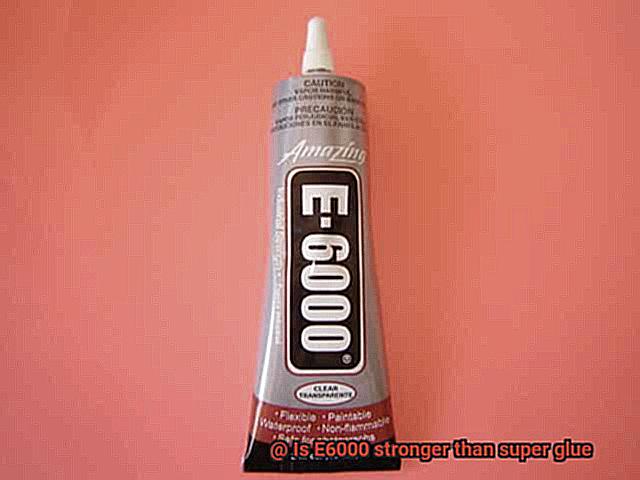
Both E6000 and super glue need to be stored in cool, dry places to stay in tip-top shape. Nobody wants dried-out glue ruining their day.
Drying Times for E6000 and Super Glue
When it comes to adhesive superheroes, E6000 and super glue are two heavyweights in the crafting world. But what sets them apart? One key difference lies in their drying times. Let’s delve deeper into this fascinating aspect of these glues.
E6000, known for its patience and precision, takes around 24 hours to fully cure and reach its maximum strength. Now, I can already hear some of you gasping at the thought of waiting a whole day for your project to dry. But fear not, my fellow crafters, for this extended drying time comes with its own set of benefits. The longer curing period allows you to reposition or adjust your materials before they fully set, giving you more flexibility in your bonding process. Imagine being able to fine-tune your masterpiece even after applying the glue.
Moreover, E6000’s slow-drying nature allows it to penetrate deeper into the materials, creating a bond that stands the test of time. So if you’re looking for a glue that offers both strength and flexibility, E6000 might just be your new crafting companion.
Now let’s turn our attention to super glue, the lightning-fast hero of quick fixes and instant bonding. This adhesive works its magic in mere seconds or minutes, depending on the specific formula and brand. Talk about efficiency.
The quick drying time of super glue makes it a go-to choice for those urgent repairs or projects that require immediate bonding. Need to fix a broken figurine before your favorite aunt visits? Super glue has got your back. However, it’s important to note that while super glue dries quickly, it may take up to 24 hours to reach its maximum strength.
So while you may have an instant bond, it’s still worth exercising caution until the glue has fully cured.
Factors Affecting the Strength of an Adhesive
In the realm of crafting and DIY projects, finding the perfect adhesive is like discovering a superhero with unparalleled strength. But what lies beneath the surface of this bonding phenomenon? What factors determine the strength of an adhesive? From chemical composition to environmental influences, unraveling these secrets will equip you with the knowledge to choose the right adhesive for any project, ensuring an unyielding bond.
So, fasten your seatbelt and embark on a scientific journey into the world of adhesive strength.
Chemical Composition:
The key to an adhesive’s strength lies within its chemical composition. Each adhesive is meticulously formulated using specific chemicals that offer varying levels of bonding power. For instance, cyanoacrylate adhesive (commonly known as super glue) boasts a fast-acting and incredibly strong-bonding composition. On the other hand, E6000 employs a distinct formula designed for flexibility and durability.
Surface Preparation:
Proper surface preparation is paramount in achieving a robust bond. Surfaces must be pristine, dry, and free from contaminants such as oil, grease, or dust particles. Neglecting this critical step in the bonding process can hinder adhesion and compromise overall strength.
Temperature and Humidity:
Adhesives are sensitive beings when it comes to temperature and humidity during application and curing. Extreme temperatures can render them brittle or diminish their bonding prowess. High humidity levels interfere with curing, resulting in weaker bonds. Understanding the ideal temperature range for each adhesive ensures maximum bond strength.
Application Technique:
The manner in which an adhesive is applied significantly impacts its bonding strength. Strict adherence to manufacturer instructions regarding application technique is vital for optimal results. Applying too much or too little adhesive can weaken the bond, making precision a crucial element in the quest for unyielding strength.
Substrate Compatibility:
Not all adhesives harmonize with every material. Substrate compatibility is a critical factor in achieving a robust and enduring bond. Careful consideration of the adhesive’s compatibility with the materials being bonded ensures a successful connection.
Curing Time:
Adhesives require a specific amount of time to fully cure and reach their maximum strength. Rushing the curing process by subjecting the adhesive to stress or load prematurely weakens the bond. Patience becomes the ultimate virtue when it comes to adhesive strength.
Environmental Factors:
Over time, environmental conditions such as sunlight exposure, chemical contact, or moisture levels can impact an adhesive’s strength. Some adhesives possess superior resistance to such factors, making them ideal for applications where durability is paramount.
Conclusion
In the ultimate battle of adhesive supremacy, E6000 emerges as the undisputed champion.
With its unrivaled strength and durability, E6000 surpasses super glue in every aspect. Its bond is unbreakable, holding together even the toughest materials with ease.
Say goodbye to weak bonds and hello to the power of E6000.


